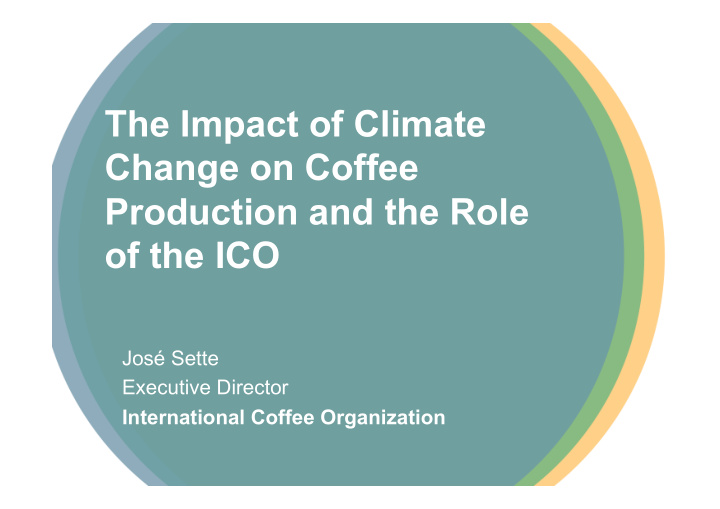



The Impact of Climate Change on Coffee Production and the Role of the ICO José Sette Executive Director International Coffee Organization
GLOBAL DEMAND/SUPPLY BALANCE 160 140 120 million 60-kg bags 100 80 60 40 20 0 Crop years Total consumption* Total production *Consumption for importing countries on coffee year basis
CHANGE IN WORLD SHARES OF CONSUMPTION Source: ICO
POTENTIAL FOR FURTHER GROWTH IN DEMAND • Large potential for further growth in exporting countries and emerging markets • Per capita rates still well below those in traditional markets • Particularly in countries with large populations (China, India, Indonesia) • Brazil as the model for other countries to emulate
WILL POSITIVE SUPPLY TREND CONTINUE? 160 14000 1400 140 12000 1200 120 10000 1000 thoushand hectares million 60-kg bags 100 8000 800 kg/ha 80 6000 600 60 4000 400 40 2000 200 20 0 0 0 Average annual production Area Yield
SUPPLY GAP IN 2030? World Coffee Consumption 250 200 million 60-kg bags 150 100 50 0 1990 1995 2000 2005 2010 2015 2020 2025 2030
Major Factor: Climate Change
IMPACT OF CLIMATE CHANGE ON COFFEE PRODUCTION • Global warming affects coffee production via two pathways 1. Higher temperatures & changes in rainfall patterns make regions unsuitable for production 2. Changes in climatic conditions facilitate spread of pests and diseases (e.g. Coffee Leaf Rust
IMPACT OF CLIMATE CHANGE ON COFFEE PRODUCTION • Both Arabica and Robusta are negatively affected by climate change • Arabica shows lower yields and worse quality due to higher mean temperatures • Robusta is affected by extreme weather events (especially droughts) in current production areas
CLIMATE CHANGE IMPACT ON LAND SUITABILITY • Studies project loss in suitability using IPCC emission scenarios (RPC 2.6/ RPC 6.0/ RPC 8.5) • Across scenarios, models predict that 50% of current coffee area will become unsuitable for production • Visualisation of results disaggregated by coffee species
SUITABILITY OF CURRENT ARABICA AREA IN 2050 Source: Bunn et al. 2015
SUITABILITY OF CURRENT ROBUSTA AREA IN 2050 Source: Bunn et al. 2015
EXTREME WEATHER VARIABILITY LED TO LARGEST OUTBREAK OF COFFEE LEAF RUST IN MESOAMERICA DURING 2013 Area affected by leaf rust (2013) Area in 1000s hectares Jamaica Panama Not impacted Costa Rica Impacted Nicaragua Dom. Rep. El Salvador Guatemala Honduras 0 75 150 225 300 Causes: Impacts: Rain and temperature variability • >50% area was impacted by coffee leaf rust Humidity: ideal conditions for spores • Estimated 375,000 jobs lost • US$500 mlns in economic loss
HEAVY RAINFALL DURING 2007-10 IN COLOMBIA LED TO INFRASTRUCTURE DAMAGE AND A COFFEE LEAF RUST OUTBREAK Causes: Impacts: • Rainfall: 40% more than average • Significant infrastructure damage • Decreased sunshine hours by 15-30% • Coffee leaf rust outbreak • Cooling temperatures by 0.8°C • 95% of farmers affected; US$500 mln in relief
BRAZIL’S 2014 DROUGHT LIKELY MORE INTENSE DUE TO CLIMATE CHANGE – DROUGHT HAS A HIGHER BASE TEMPERATURE Causes: Impacts: • Rain deficit of ~500 mm in Minas Gerais • Much of state’s coffee in hardest hit zones • Drought combined with high temperatures • Coffee berries not filling • Reg. warming caused by land-use change • 2014: no data on jobs and economic loss
MITIGATION ACTIONS CAN BUFFER IMPACT OF CLIMATE CHANGE … • Agronomic techniques and genomic research provide solutions: – Shade trees, mulching – Irrigation where appropriate – Development & dissemination of coffee varieties with tolerance to climate stress
… BUT CHALLENGES REMAIN … • Coffee is a perennial (tree) crop à lead times for adaptation measures (e.g. breeding & replanting) are very long • Adaptation at farm level requires investment, but producers have limited access to finance
… WHILE MIGRATION IS NOT A PANACEA EITHER • Moving production into higher elevations – Scope varies between countries (e.g. Ethiopia could have a net gain of 400% in production area, but many others would lose) – Negative consequences of changes in land use patterns need to be considered
ROLE OF THE ICO MISSION: Promote a sustainable world coffee sector 5-YEAR ACTION PLAN: 1. Disseminate world-class data and analytics to inform decision makers 2. Provide forum for discussion of coffee matters among & between public and private sectors 3. Enable sector development projects and promote consumption through public-private partnerships
ROLE OF THE ICO Disseminate world-class data and analytics to inform decision makers • ICC 103-6 Rev. 1 “Climate change and coffee”, • ICC 114-7 “Guide for Financing Climate-Related Activities in the Coffee Sector” • SC 75 “Recent studies on the impact of climate change on coffee production”
ROLE OF THE ICO Provide forum for discussion of coffee matters among & between public and private sectors • ‘Climate change, time for action’ session (2014) • Submissions to UN Framework Convention on Climate Change and FAO/GACSA • Exchanges of information on national coffee policies • Consultative Forum on Coffee Sector Finance
ROLE OF THE ICO Enable sector development projects and promote consumption through public-private partnerships • Work with private sector/civil society initiatives: – Global Coffee Platform – World Coffee Research – Coffee Global Adaptation Plan – Coffee & Climate – etc.
CONCLUSIONS • Coffee sector faced with challenge to meet future demand amid negative impact of climate change • Solutions for mitigation are being developed, but dissemination needs to be accelerated • Migration should be driven by market forces, while negative impact of land use change must be minimized • Role for governments to strengthen institutions for research and technology transfer to farmers • ICO has important role to play in providing and exchanging information; international advocacy; and bringing together public sector with private and civil society initiatives
Thank you
Recommend
More recommend